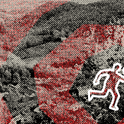The wonderful thing about living on an island is that there are endless opportunities to swim. In recent months, I’ve been overtaken by sudden urges to shed my clothes and slip into the sea, like a selkie in reverse. The waters are cold, of course—this being the wild Atlantic or the North Sea, depending on which coast I find myself on—but still so much warmer than in winter as to feel a blessed relief.
Warmer waters bring their own hazards, however. As temperatures heated up back in the summer, the jellyfish proliferated. When striking out from shore, you have to stay alert. They drift by like Chinese lanterns beneath the waves. Lion’s mane jellyfish have been our most common sighting this year: clear lozenges the size of dinner plates, trailing streamers of burnt orange, plum and burgundy. Avoid them: they can give you a nasty sting. But if you do manage to keep your distance, they are fascinating creatures to watch.
Last week, when we clambered down to swim in the deep, still waters of a narrow inlet, we found ourselves sharing this sheltered pool with a single lion’s mane, which pulsed gently around the perimeter, opening and closing like a set of bellows. As it approached, we would withdraw and wait for it to pass by—quite harmless, moving at a tranquil, meandering pace. Certainly unaware of our presence. Jellyfish have no eyes, no ears, no brain, no heart. Still, they seem to do alright—most of the time.
This lack of perception does leave them vulnerable, however. After a stormy night, we’ll often discover dozens of them washed up on the beach, their gelatinous, almost formless, bodies melting away into the pebbles. A few years ago, near Torridon, we rounded a rocky headland to find the cove beyond filled with a thousand moon jellyfish or more—what is called a “bloom.” Each frosted disc bore four pale “eyes” (in reality sexual organs) and the whole conglomeration of creatures had been set whirling and swirling in the waves, coming together and apart, to create an iterative, almost hallucinogenic effect like that of a hall of mirrors. It was a strange and beautiful sight. But wretched too—for most, if not all of them, were dead: dashed helplessly against the rocks.
It seemed a curio, then. A startling natural phenomenon, admittedly one that was unsettling. A textbook boom and bust cycle exhibited right in front of us. But this year, picking my way through the detritus of the storms, the plight of the jellyfish felt somehow more apt, more meaningful and perhaps a lot closer to home.
After months of mute acceptance as our autonomy and freedom have been curtailed and stripped away, our life plans redirected by greater forces, I have never felt more at the mercy of the currents. So often this year I have felt my ability to comprehend what is happening—and, more specifically, my ability to identify the best course of action—pushed beyond its limits. As overwhelming month succeeded overwhelming month, I found myself shying away from the news, with all its frightening and often contradictory reports, and craving simplicity—clear instruction, reassurance, explanations in only the very simplest terms.
Like the jellyfish, I often feel that I’ve been floating blindly through the crisis, and I don’t think I’m alone. At the time of writing, we are bracing for the metaphorical second wave to hit. With case numbers rising, the swell could suck us all under. Scientists told us it would happen, yet still, now it’s here, I feel I almost didn’t see it coming. One can only keep on keeping on—beating on, against the current—and hoping not to be swept against the rocks.












